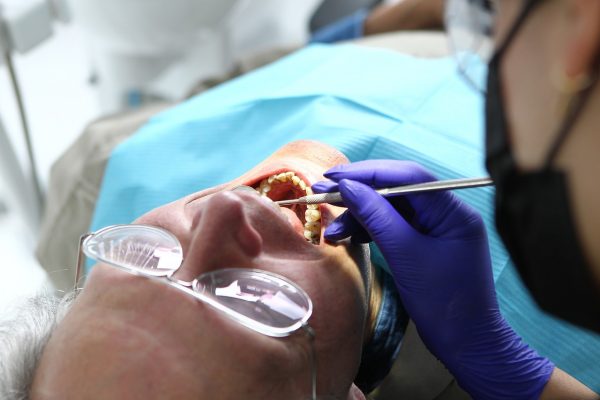I’ve been using a water pic for about the past three months. And on my most recent dental cleaning, the hygienist at my dentist’s office was amazed. I had no plaque!
They wondered what I had been doing, and I explained that I had added the water pic to my daily dental routine.
It acts like dental floss, except that it uses a jet of water to irrigate all of those tight spaces and crevices between your teeth and at your gumline. That means it can flush plaque and bacteria out of the periodontal pockets under your gumline where it gathers and can lead to infection.
Once these areas become infected, periodontitis (gum disease) is likely to follow.
This is going to cause a low grade chronic systemic inflammatory response that not only affects your oral health, but the health of your entire body.
You see, all of those nasty, gum-destroying bacteria don’t just stay in your mouth. They also escape into your bloodstream and are carried through your body to distant organs.
Once there, they wreak all sorts of havoc.
- They damage the walls of your blood vessels, contribute to the buildup of arterial plaque and have a significant association with the development of cardiovascular disease.
- The chronic infection and inflammation caused by gum disease is associated with twice the chance of a stroke and is linked to hardening of large arteries in the brain.
- The bacterial DNA from dental gingivitis can slip into the synovial fluid around your joints. This causes inflammation, pain, stiffness… and arthritis.
- These bacteria can travel from your mouth to your brain, where it appears to play a role in the development of Alzheimer’s. In fact, older adults with signs of periodontitis are more likely to develop Alzheimer’s.
- Chronic periodontitis is also linked to an increased risk of erectile dysfunction and diabetes.
Are You at Risk?
Almost half of all Americans 30 and older have periodontal gum infections. But in the 65-plus population, the percentage of people with periodontitis leaps to nearly 60%. This makes gum disease a major health threat to older individuals.
Gums that are red, swollen, tender or bleed easily are all common symptoms of periodontal disease. Chronic bad breath, teeth that are loose or sensitive, receding gum lines that make your teeth look longer than normal, and pain while chewing are also signs of problems.
If you have any of these issues, make an appointment with your dentist for a thorough exam and cleaning to remove any harmful bacteria and plaque buildup. Then, follow up with good dental hygiene.
The Secret to Healthier Gums
Some of my patients are diligent about their dental care. They brush and gargle two or three times a day, and floss after every meal.
Others might care for their teeth only once a day. Some floss, some don’t. Some rinse, some don’t. Your best bet is to practice the following, very simple routine twice a day.
- Brush twice daily with a toothpaste that is free of fluoride, carrageenan, formaldehyde, triclosan and polyethylene glycol (PEG). You can also search the internet for ways to make your own, natural, homemade baking soda toothpaste.
- Follow-up with a good flossing.
- If you have a water pick, use that right after flossing to remove any remaining debris.
- Rinse with a mouthwash that’s fluoride, alcohol and sugar free.
- Visit your dental care professional at least every six months for a good cleaning and exam. If you have gum disease, increase the number of visits. Get checked out every two to three months.
It’s also a good idea to replenish your oral flora with a good probiotic. This creates an environment that resists colonization of bad bacteria. The fewer bad bacteria in your mouth, the fewer will affect the other organs in your body.
SOURCES:
Nazir MA. Prevalence of periodontal disease, its association with systemic diseases and prevention. Int J Health Sci (Qassim). 2017 Apr-Jun;11(2):72-80.
Sanz M, Marco Del Castillo A, Jepsen S, Gonzalez-Juanatey JR, D’Aiuto F, Bouchard P, Chapple I, Dietrich T, Gotsman I, Graziani F, Herrera D, Loos B, Madianos P, Michel JB, Perel P, Pieske B, Shapira L, Shechter M, Tonetti M, Vlachopoulos C, Wimmer G. Periodontitis and cardiovascular diseases: Consensus report. J Clin Periodontol. 2020 Mar;47(3):268-288.
Gum disease, inflammation, hardened arteries may be linked to stroke risk. American Heart Association. 2020 Feb.
Baniulyte G, Piela K, Culshaw S. How strong is the link between periodontitis and stroke? Evid Based Dent. 2021 Jan;22(1):10-11.
Reichert S, Haffner M, Keyßer G, Schäfer C, Stein JM, Schaller HG, Wienke A, Strauss H, Heide S, Schulz S. Detection of oral bacterial DNA in synovial fluid. J Clin Periodontol. 2013 Jun;40(6):591-8.
Dominy SS, et al. Porphyromonas gingivalis in Alzheimer’s disease brains: Evidence for disease causation and treatment with small-molecule inhibitors. Sci Adv. 2019 Jan 23;5(1):eaau3333.
Oral health and Alzheimer’s risk. Alzheimer’s Association. Press Release. 2023 Jan.
Farook F, Al Meshrafi A, Mohamed Nizam N, Al Shammari A. The Association Between Periodontitis and Erectile Dysfunction: A Systematic Review and Meta-Analysis. Am J Mens Health. 2021 May-Jun;15(3):15579883211007277.
Periodontal Disease in Adults (Age 30 or Older). National Institute of Dental and Craniofacial Research. Last reviewed Aug 2021.
Chugh P, Dutt R, Sharma A, Bhagat N, Dhar MS. A critical appraisal of the effects of probiotics on oral health. JFF. 70(2020): 103985.
Zhang Y, Ding Y, Guo Q. Probiotic Species in the Management of Periodontal Diseases: An Overview. Front Cell Infect Microbiol. 2022 Mar 25;12:806463.



